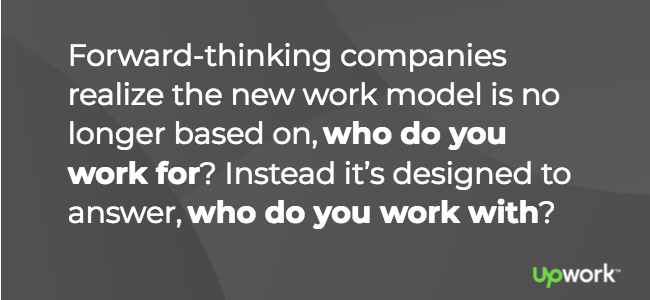Did you know agility is the new efficiency? Chances are, your company follows a traditional work model based on hierarchical roles. Although the model worked for decades, it’s too slow and cumbersome for today’s business needs. That old model was designed during the Industrial Age when people worked primarily in factories and strived for efficiency. Today’s new work model focuses on agility.
Companies need more agility because in our digital world, disruption is an everyday threat. The new business environment requires companies learn faster and adapt swiftly to change, while supporting the shifting demands of their workforce.
To function with higher agility, speed, and adaptability, companies are getting work done through flexible project teams. This shift requires companies…
Focus on skills, not roles
Patty McCord, former Chief Talent Officer of Netflix, suggests seeing talent “in terms of fungible, flexible, agile groups of people that come together, then disband. Then come together in another group and disband again.”
McCord says to look past roles and see each worker as “different cards in your deck.” Then create processes that:
- Look at your employees and contingent workers to identify all the cards (talent) you have in your deck.
- Figure out what cards you need for the game you’re playing. Know what talent you need and at what skill level to get the work done.
- Deeply understand what you’re trying to do, then rearrange the teams and the talent to do it.
Project teams can be made up of employees or contingent workers. Growing in popularity are hybrid teams where employees perform the ongoing work that moves your company forward. And freelancers provide project-based work requiring specialized skills. Hybrid teams function in an agile way by focusing on assembling the right skills for a project.
Do whatever it takes to create your ideal deck of players. “If you’re going to build something that has a whole bunch of incremental builds in it, then freelancers might be a critically important part,” says McCord.
How a project-based approach helped UCLA achieve a monster goal
When you think of work as a series of projects, it’s easier to see what talent you need to achieve your goals. Remember, there’s no work that’s too big for a project team. One of the advantages of a project-based approach is that you don’t need to pull all your talent together at the same time. You can break large projects down into smaller components, then pull in the talent you need, at the point of the project when you need them
By optimizing when you engage the right experts, you can get work done faster, and more cost-effectively.
When UCLA received a grant to create an e-learning platform, they faced a difficult task. The university only had one person on the project, Professor Christopher Lee. What’s more, Lee had to build the new platform on a limited budget and within a tight deadline.
Lee needed developers and specialists in web operations production, and deployment, so he built a project-based team. Many of the skills needed on the project were outside of UCLA’s scope and difficult to find, so Lee sourced talent through Upwork Enterprise, a freelancing solution with a built-in global talent source.
Lee brought on three program consultants to free him from time-consuming daily tasks. The program consultants “raised strategic questions that had to be addressed, but I couldn’t think about them before while stuck in all of these endless task lists by myself,” says Lee. “They really allowed me to get out of just putting out fires to taking the time to really strategize [with them]. So we got what I call wave after wave of transformation to raise the game.”
Facing a tight budget and turnaround times, the consultants knew they must bring in highly skilled talent as needed, so that work gets done accurately and quickly. The consultants brought on web programmers skilled in Django, Python, and LTI (Learning Tools Interoperability) implementation. They also brought on specialists in data mining and research, DevOps, and UI/UX. Their usability expert transformed the design in under four weeks.
By assembling a flexible team of talent who completed projects at the right time, the team built and deployed the e-learning platform in just three months and within budget.
Letting go of limitations
Deloitte’s Global Human Capital Trends survey shows 88% of companies believe it’s important to redesign their work model, but only 11% of companies know how to do it. When tackling a large project, it can be difficult to know how to break it down enough to understand what talent you need, at what skill level, and at what phase in the project.
When this happens, you may want to add a program consultant or program manager to your deck of required talent. As UCLA learned, program consultants not only keep the project on schedule, they can also help raise the project’s result.
If you utilize a Freelancer Management System (FMS) or other contingent workforce solution, it may provide advisors. Such as how Upwork Enterprise clients can utilize Upwork Professionals, who provide expertise to use the solution efficiently.
The resources are out there to help you work with more speed and agility. What companies are realizing is by breaking work down into flexible project teams, companies remove preconceived limitations. You’ll see how much more your current staff can produce and at what higher level they can innovate.


